Comparative Analysis of Business Environments: MTR, Orbis, and Yip
VerifiedAdded on 2020/03/16
|18
|7129
|68
Report
AI Summary
This report provides a comprehensive analysis of the business environment, particularly within an international context. It explores various types of organizations, including sole traders, partnerships, and limited companies, and examines the growth of the international business environment. The report delves into market entry strategies such as franchising, licensing, and joint ventures, evaluating their advantages and disadvantages. It then focuses on specific companies, including MTR, Orbis International, and Yip, Tse and Tang & Partner C. Ltd., providing background information, mission statements, and analyses of their legal structures and potential conflicts of interest. Furthermore, the report discusses the functions of MTR, its organizational structure, and its global expansion plans, concluding with an overview of the challenges and opportunities in the evolving global market.
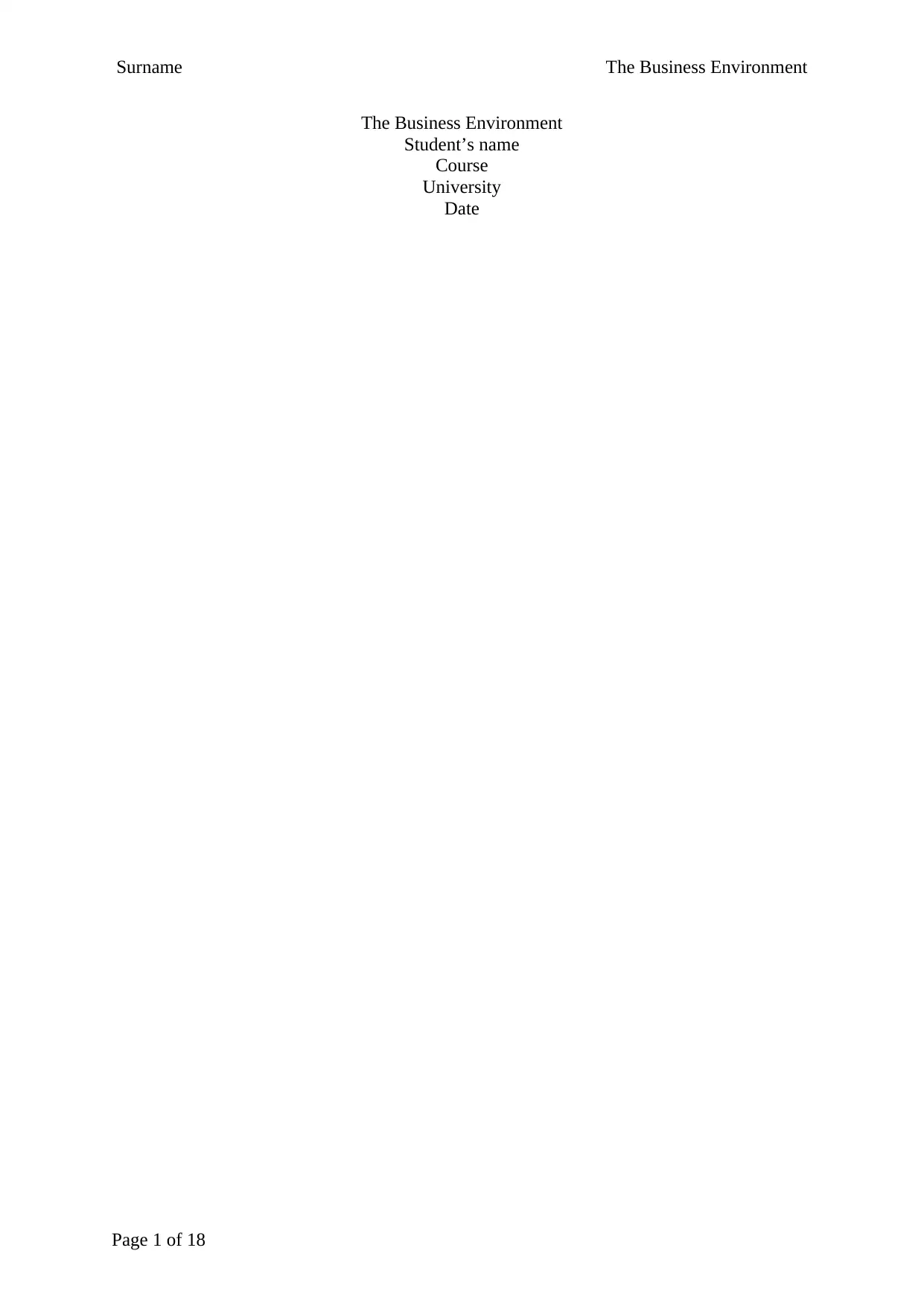
Surname The Business Environment
The Business Environment
Student’s name
Course
University
Date
Page 1 of 18
The Business Environment
Student’s name
Course
University
Date
Page 1 of 18
Paraphrase This Document
Need a fresh take? Get an instant paraphrase of this document with our AI Paraphraser
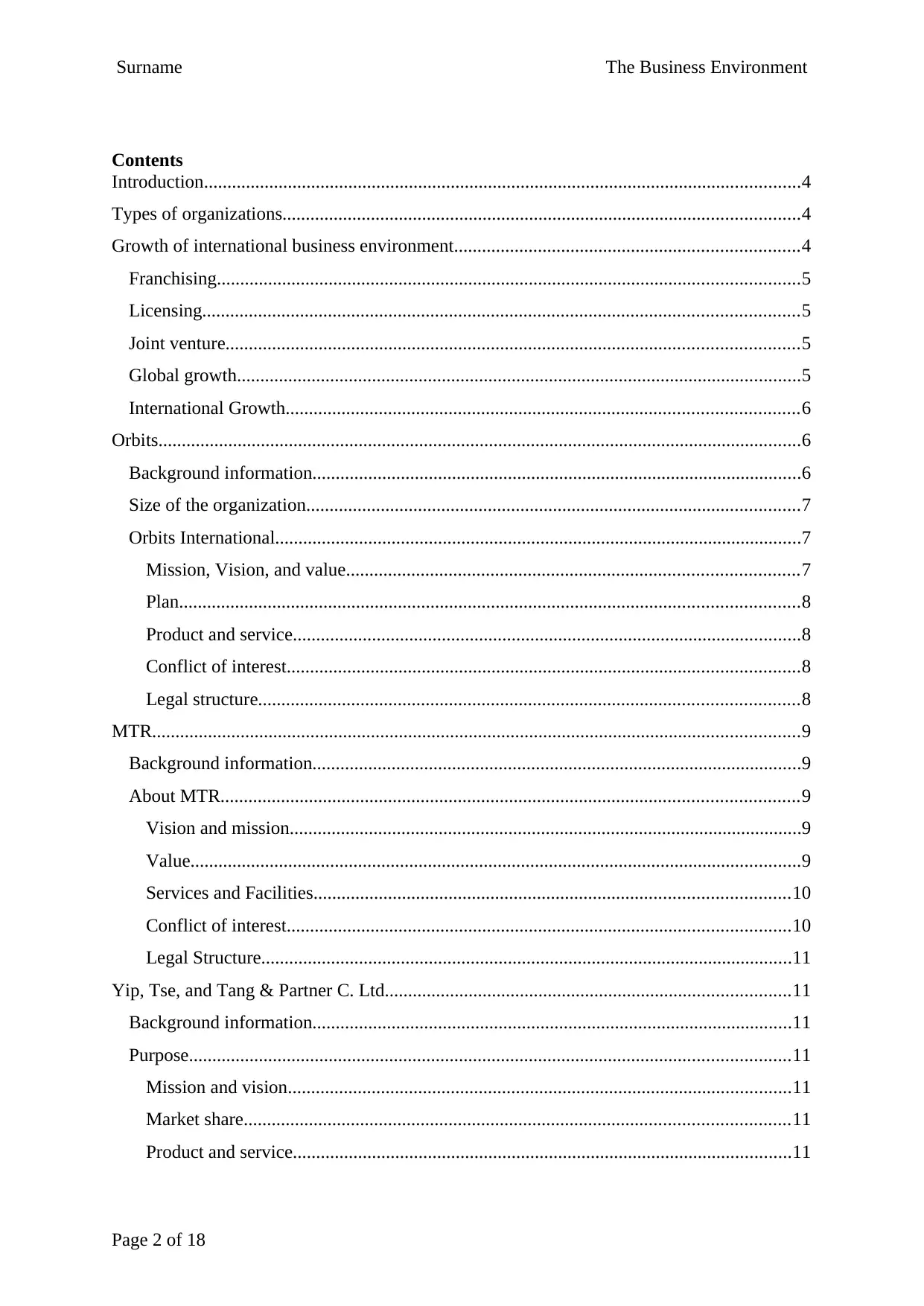
Surname The Business Environment
Contents
Introduction................................................................................................................................4
Types of organizations...............................................................................................................4
Growth of international business environment..........................................................................4
Franchising.............................................................................................................................5
Licensing................................................................................................................................5
Joint venture...........................................................................................................................5
Global growth.........................................................................................................................5
International Growth..............................................................................................................6
Orbits..........................................................................................................................................6
Background information.........................................................................................................6
Size of the organization..........................................................................................................7
Orbits International.................................................................................................................7
Mission, Vision, and value.................................................................................................7
Plan.....................................................................................................................................8
Product and service.............................................................................................................8
Conflict of interest..............................................................................................................8
Legal structure....................................................................................................................8
MTR...........................................................................................................................................9
Background information.........................................................................................................9
About MTR............................................................................................................................9
Vision and mission..............................................................................................................9
Value...................................................................................................................................9
Services and Facilities......................................................................................................10
Conflict of interest............................................................................................................10
Legal Structure..................................................................................................................11
Yip, Tse, and Tang & Partner C. Ltd.......................................................................................11
Background information.......................................................................................................11
Purpose.................................................................................................................................11
Mission and vision............................................................................................................11
Market share.....................................................................................................................11
Product and service...........................................................................................................11
Page 2 of 18
Contents
Introduction................................................................................................................................4
Types of organizations...............................................................................................................4
Growth of international business environment..........................................................................4
Franchising.............................................................................................................................5
Licensing................................................................................................................................5
Joint venture...........................................................................................................................5
Global growth.........................................................................................................................5
International Growth..............................................................................................................6
Orbits..........................................................................................................................................6
Background information.........................................................................................................6
Size of the organization..........................................................................................................7
Orbits International.................................................................................................................7
Mission, Vision, and value.................................................................................................7
Plan.....................................................................................................................................8
Product and service.............................................................................................................8
Conflict of interest..............................................................................................................8
Legal structure....................................................................................................................8
MTR...........................................................................................................................................9
Background information.........................................................................................................9
About MTR............................................................................................................................9
Vision and mission..............................................................................................................9
Value...................................................................................................................................9
Services and Facilities......................................................................................................10
Conflict of interest............................................................................................................10
Legal Structure..................................................................................................................11
Yip, Tse, and Tang & Partner C. Ltd.......................................................................................11
Background information.......................................................................................................11
Purpose.................................................................................................................................11
Mission and vision............................................................................................................11
Market share.....................................................................................................................11
Product and service...........................................................................................................11
Page 2 of 18
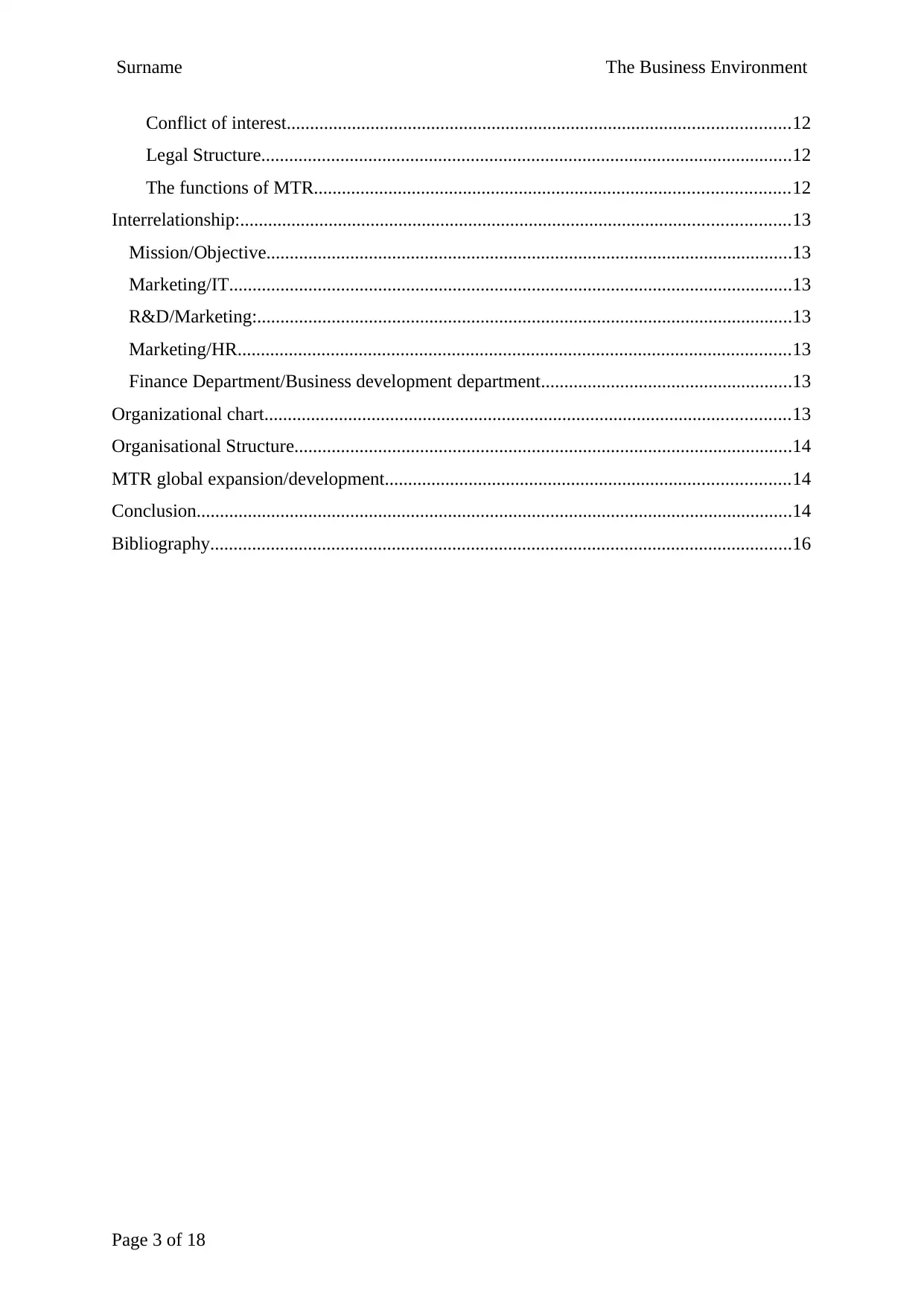
Surname The Business Environment
Conflict of interest............................................................................................................12
Legal Structure..................................................................................................................12
The functions of MTR......................................................................................................12
Interrelationship:......................................................................................................................13
Mission/Objective.................................................................................................................13
Marketing/IT.........................................................................................................................13
R&D/Marketing:...................................................................................................................13
Marketing/HR.......................................................................................................................13
Finance Department/Business development department......................................................13
Organizational chart.................................................................................................................13
Organisational Structure...........................................................................................................14
MTR global expansion/development.......................................................................................14
Conclusion................................................................................................................................14
Bibliography.............................................................................................................................16
Page 3 of 18
Conflict of interest............................................................................................................12
Legal Structure..................................................................................................................12
The functions of MTR......................................................................................................12
Interrelationship:......................................................................................................................13
Mission/Objective.................................................................................................................13
Marketing/IT.........................................................................................................................13
R&D/Marketing:...................................................................................................................13
Marketing/HR.......................................................................................................................13
Finance Department/Business development department......................................................13
Organizational chart.................................................................................................................13
Organisational Structure...........................................................................................................14
MTR global expansion/development.......................................................................................14
Conclusion................................................................................................................................14
Bibliography.............................................................................................................................16
Page 3 of 18
⊘ This is a preview!⊘
Do you want full access?
Subscribe today to unlock all pages.

Trusted by 1+ million students worldwide
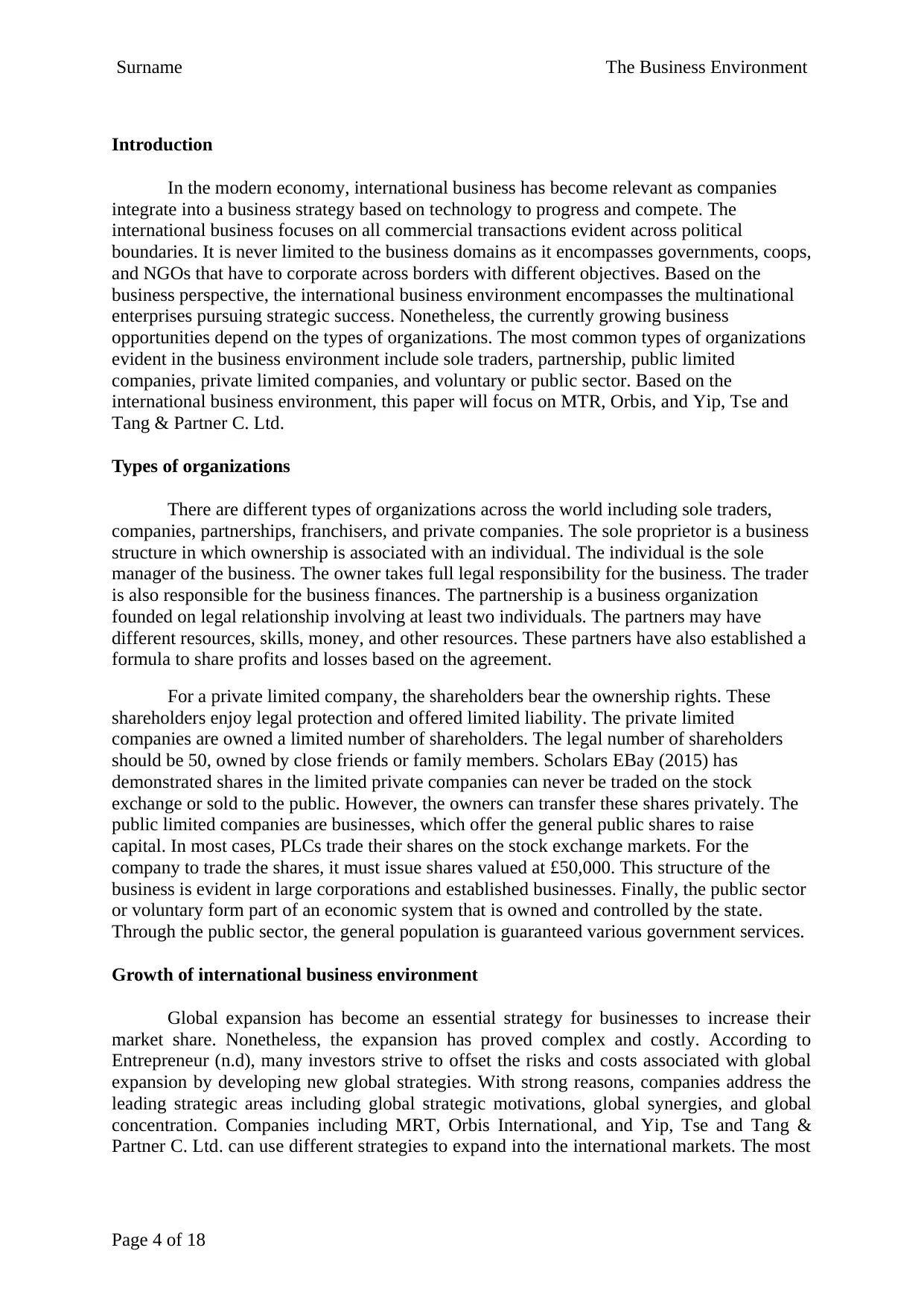
Surname The Business Environment
Introduction
In the modern economy, international business has become relevant as companies
integrate into a business strategy based on technology to progress and compete. The
international business focuses on all commercial transactions evident across political
boundaries. It is never limited to the business domains as it encompasses governments, coops,
and NGOs that have to corporate across borders with different objectives. Based on the
business perspective, the international business environment encompasses the multinational
enterprises pursuing strategic success. Nonetheless, the currently growing business
opportunities depend on the types of organizations. The most common types of organizations
evident in the business environment include sole traders, partnership, public limited
companies, private limited companies, and voluntary or public sector. Based on the
international business environment, this paper will focus on MTR, Orbis, and Yip, Tse and
Tang & Partner C. Ltd.
Types of organizations
There are different types of organizations across the world including sole traders,
companies, partnerships, franchisers, and private companies. The sole proprietor is a business
structure in which ownership is associated with an individual. The individual is the sole
manager of the business. The owner takes full legal responsibility for the business. The trader
is also responsible for the business finances. The partnership is a business organization
founded on legal relationship involving at least two individuals. The partners may have
different resources, skills, money, and other resources. These partners have also established a
formula to share profits and losses based on the agreement.
For a private limited company, the shareholders bear the ownership rights. These
shareholders enjoy legal protection and offered limited liability. The private limited
companies are owned a limited number of shareholders. The legal number of shareholders
should be 50, owned by close friends or family members. Scholars EBay (2015) has
demonstrated shares in the limited private companies can never be traded on the stock
exchange or sold to the public. However, the owners can transfer these shares privately. The
public limited companies are businesses, which offer the general public shares to raise
capital. In most cases, PLCs trade their shares on the stock exchange markets. For the
company to trade the shares, it must issue shares valued at £50,000. This structure of the
business is evident in large corporations and established businesses. Finally, the public sector
or voluntary form part of an economic system that is owned and controlled by the state.
Through the public sector, the general population is guaranteed various government services.
Growth of international business environment
Global expansion has become an essential strategy for businesses to increase their
market share. Nonetheless, the expansion has proved complex and costly. According to
Entrepreneur (n.d), many investors strive to offset the risks and costs associated with global
expansion by developing new global strategies. With strong reasons, companies address the
leading strategic areas including global strategic motivations, global synergies, and global
concentration. Companies including MRT, Orbis International, and Yip, Tse and Tang &
Partner C. Ltd. can use different strategies to expand into the international markets. The most
Page 4 of 18
Introduction
In the modern economy, international business has become relevant as companies
integrate into a business strategy based on technology to progress and compete. The
international business focuses on all commercial transactions evident across political
boundaries. It is never limited to the business domains as it encompasses governments, coops,
and NGOs that have to corporate across borders with different objectives. Based on the
business perspective, the international business environment encompasses the multinational
enterprises pursuing strategic success. Nonetheless, the currently growing business
opportunities depend on the types of organizations. The most common types of organizations
evident in the business environment include sole traders, partnership, public limited
companies, private limited companies, and voluntary or public sector. Based on the
international business environment, this paper will focus on MTR, Orbis, and Yip, Tse and
Tang & Partner C. Ltd.
Types of organizations
There are different types of organizations across the world including sole traders,
companies, partnerships, franchisers, and private companies. The sole proprietor is a business
structure in which ownership is associated with an individual. The individual is the sole
manager of the business. The owner takes full legal responsibility for the business. The trader
is also responsible for the business finances. The partnership is a business organization
founded on legal relationship involving at least two individuals. The partners may have
different resources, skills, money, and other resources. These partners have also established a
formula to share profits and losses based on the agreement.
For a private limited company, the shareholders bear the ownership rights. These
shareholders enjoy legal protection and offered limited liability. The private limited
companies are owned a limited number of shareholders. The legal number of shareholders
should be 50, owned by close friends or family members. Scholars EBay (2015) has
demonstrated shares in the limited private companies can never be traded on the stock
exchange or sold to the public. However, the owners can transfer these shares privately. The
public limited companies are businesses, which offer the general public shares to raise
capital. In most cases, PLCs trade their shares on the stock exchange markets. For the
company to trade the shares, it must issue shares valued at £50,000. This structure of the
business is evident in large corporations and established businesses. Finally, the public sector
or voluntary form part of an economic system that is owned and controlled by the state.
Through the public sector, the general population is guaranteed various government services.
Growth of international business environment
Global expansion has become an essential strategy for businesses to increase their
market share. Nonetheless, the expansion has proved complex and costly. According to
Entrepreneur (n.d), many investors strive to offset the risks and costs associated with global
expansion by developing new global strategies. With strong reasons, companies address the
leading strategic areas including global strategic motivations, global synergies, and global
concentration. Companies including MRT, Orbis International, and Yip, Tse and Tang &
Partner C. Ltd. can use different strategies to expand into the international markets. The most
Page 4 of 18
Paraphrase This Document
Need a fresh take? Get an instant paraphrase of this document with our AI Paraphraser
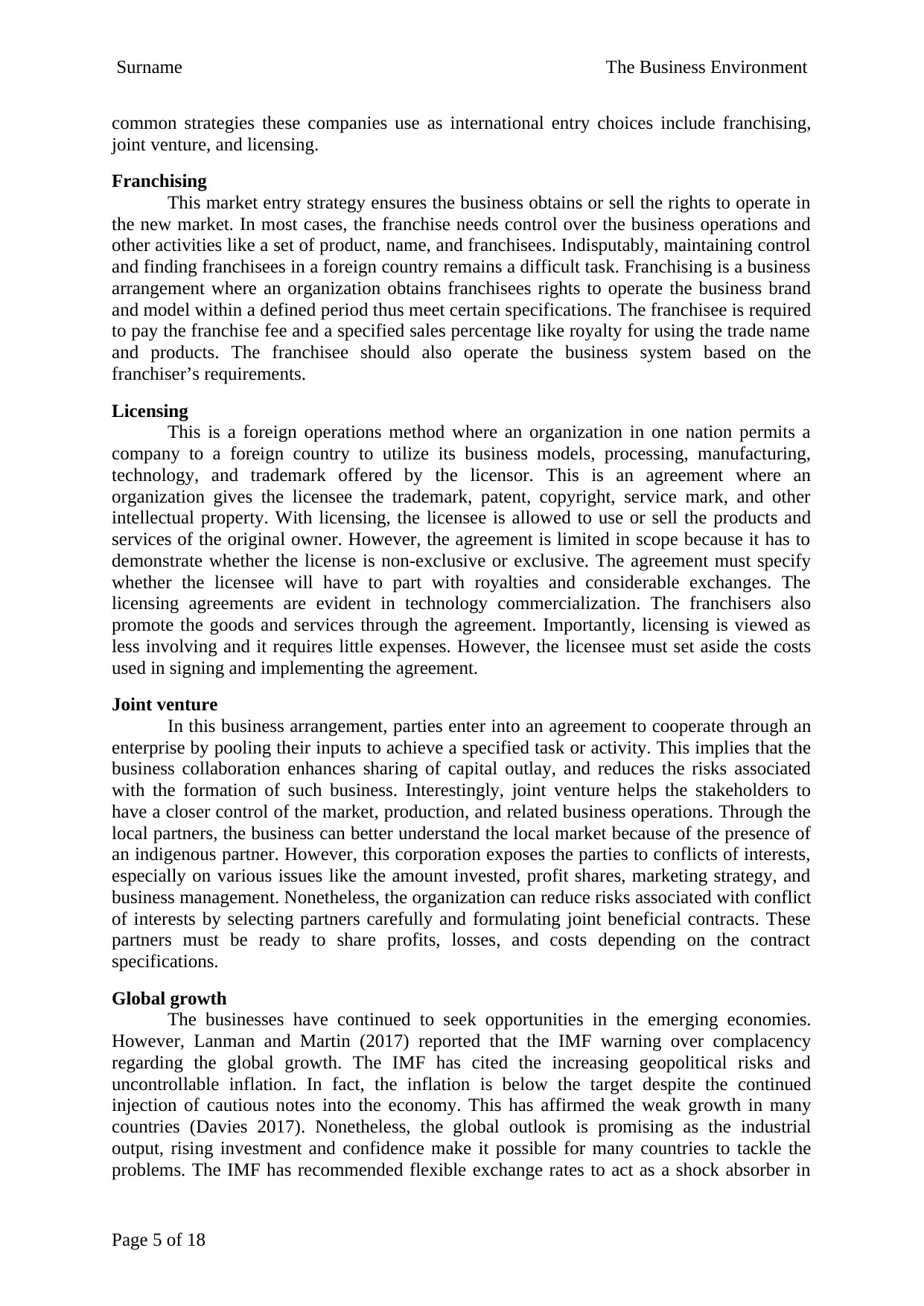
Surname The Business Environment
common strategies these companies use as international entry choices include franchising,
joint venture, and licensing.
Franchising
This market entry strategy ensures the business obtains or sell the rights to operate in
the new market. In most cases, the franchise needs control over the business operations and
other activities like a set of product, name, and franchisees. Indisputably, maintaining control
and finding franchisees in a foreign country remains a difficult task. Franchising is a business
arrangement where an organization obtains franchisees rights to operate the business brand
and model within a defined period thus meet certain specifications. The franchisee is required
to pay the franchise fee and a specified sales percentage like royalty for using the trade name
and products. The franchisee should also operate the business system based on the
franchiser’s requirements.
Licensing
This is a foreign operations method where an organization in one nation permits a
company to a foreign country to utilize its business models, processing, manufacturing,
technology, and trademark offered by the licensor. This is an agreement where an
organization gives the licensee the trademark, patent, copyright, service mark, and other
intellectual property. With licensing, the licensee is allowed to use or sell the products and
services of the original owner. However, the agreement is limited in scope because it has to
demonstrate whether the license is non-exclusive or exclusive. The agreement must specify
whether the licensee will have to part with royalties and considerable exchanges. The
licensing agreements are evident in technology commercialization. The franchisers also
promote the goods and services through the agreement. Importantly, licensing is viewed as
less involving and it requires little expenses. However, the licensee must set aside the costs
used in signing and implementing the agreement.
Joint venture
In this business arrangement, parties enter into an agreement to cooperate through an
enterprise by pooling their inputs to achieve a specified task or activity. This implies that the
business collaboration enhances sharing of capital outlay, and reduces the risks associated
with the formation of such business. Interestingly, joint venture helps the stakeholders to
have a closer control of the market, production, and related business operations. Through the
local partners, the business can better understand the local market because of the presence of
an indigenous partner. However, this corporation exposes the parties to conflicts of interests,
especially on various issues like the amount invested, profit shares, marketing strategy, and
business management. Nonetheless, the organization can reduce risks associated with conflict
of interests by selecting partners carefully and formulating joint beneficial contracts. These
partners must be ready to share profits, losses, and costs depending on the contract
specifications.
Global growth
The businesses have continued to seek opportunities in the emerging economies.
However, Lanman and Martin (2017) reported that the IMF warning over complacency
regarding the global growth. The IMF has cited the increasing geopolitical risks and
uncontrollable inflation. In fact, the inflation is below the target despite the continued
injection of cautious notes into the economy. This has affirmed the weak growth in many
countries (Davies 2017). Nonetheless, the global outlook is promising as the industrial
output, rising investment and confidence make it possible for many countries to tackle the
problems. The IMF has recommended flexible exchange rates to act as a shock absorber in
Page 5 of 18
common strategies these companies use as international entry choices include franchising,
joint venture, and licensing.
Franchising
This market entry strategy ensures the business obtains or sell the rights to operate in
the new market. In most cases, the franchise needs control over the business operations and
other activities like a set of product, name, and franchisees. Indisputably, maintaining control
and finding franchisees in a foreign country remains a difficult task. Franchising is a business
arrangement where an organization obtains franchisees rights to operate the business brand
and model within a defined period thus meet certain specifications. The franchisee is required
to pay the franchise fee and a specified sales percentage like royalty for using the trade name
and products. The franchisee should also operate the business system based on the
franchiser’s requirements.
Licensing
This is a foreign operations method where an organization in one nation permits a
company to a foreign country to utilize its business models, processing, manufacturing,
technology, and trademark offered by the licensor. This is an agreement where an
organization gives the licensee the trademark, patent, copyright, service mark, and other
intellectual property. With licensing, the licensee is allowed to use or sell the products and
services of the original owner. However, the agreement is limited in scope because it has to
demonstrate whether the license is non-exclusive or exclusive. The agreement must specify
whether the licensee will have to part with royalties and considerable exchanges. The
licensing agreements are evident in technology commercialization. The franchisers also
promote the goods and services through the agreement. Importantly, licensing is viewed as
less involving and it requires little expenses. However, the licensee must set aside the costs
used in signing and implementing the agreement.
Joint venture
In this business arrangement, parties enter into an agreement to cooperate through an
enterprise by pooling their inputs to achieve a specified task or activity. This implies that the
business collaboration enhances sharing of capital outlay, and reduces the risks associated
with the formation of such business. Interestingly, joint venture helps the stakeholders to
have a closer control of the market, production, and related business operations. Through the
local partners, the business can better understand the local market because of the presence of
an indigenous partner. However, this corporation exposes the parties to conflicts of interests,
especially on various issues like the amount invested, profit shares, marketing strategy, and
business management. Nonetheless, the organization can reduce risks associated with conflict
of interests by selecting partners carefully and formulating joint beneficial contracts. These
partners must be ready to share profits, losses, and costs depending on the contract
specifications.
Global growth
The businesses have continued to seek opportunities in the emerging economies.
However, Lanman and Martin (2017) reported that the IMF warning over complacency
regarding the global growth. The IMF has cited the increasing geopolitical risks and
uncontrollable inflation. In fact, the inflation is below the target despite the continued
injection of cautious notes into the economy. This has affirmed the weak growth in many
countries (Davies 2017). Nonetheless, the global outlook is promising as the industrial
output, rising investment and confidence make it possible for many countries to tackle the
problems. The IMF has recommended flexible exchange rates to act as a shock absorber in
Page 5 of 18
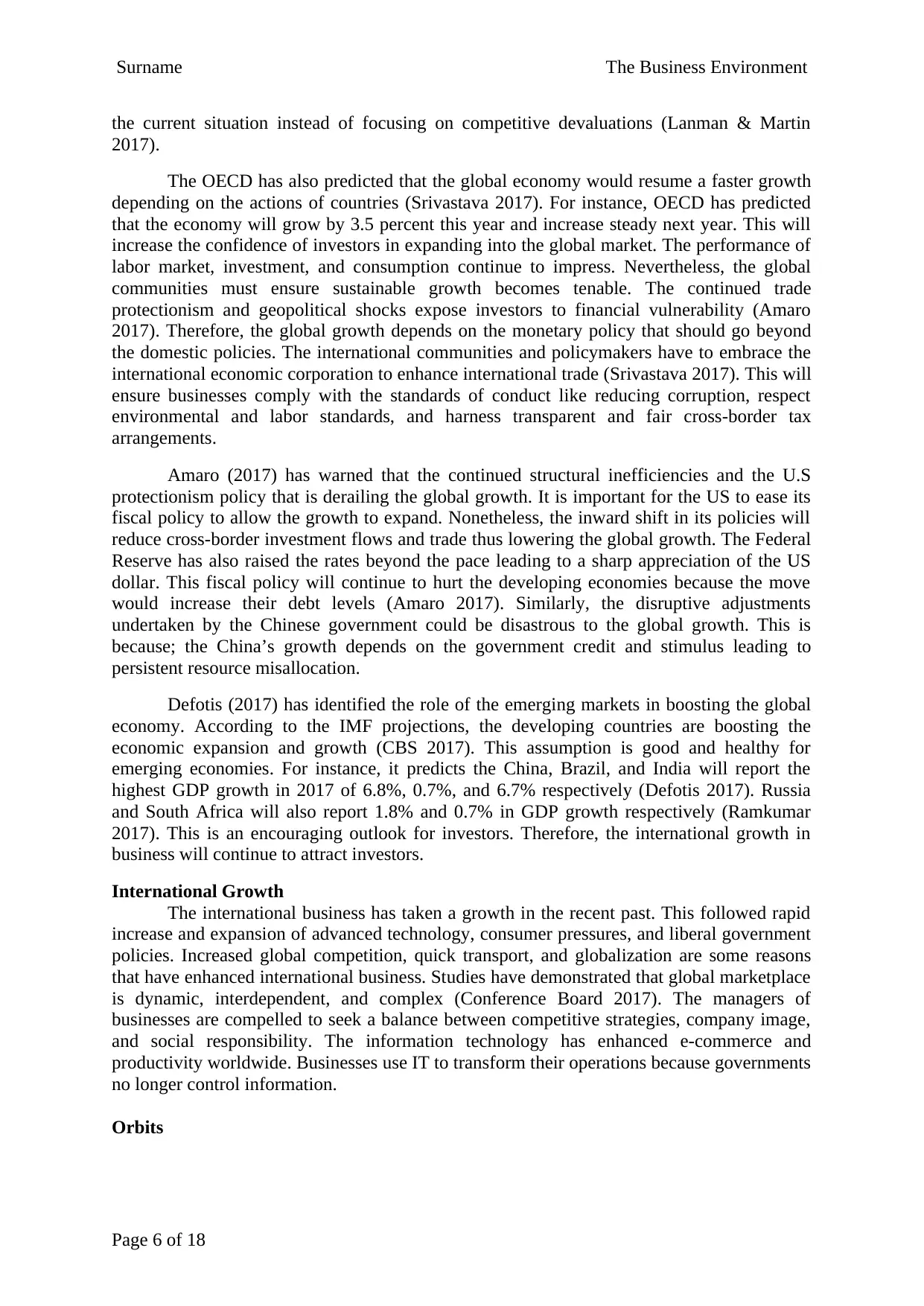
Surname The Business Environment
the current situation instead of focusing on competitive devaluations (Lanman & Martin
2017).
The OECD has also predicted that the global economy would resume a faster growth
depending on the actions of countries (Srivastava 2017). For instance, OECD has predicted
that the economy will grow by 3.5 percent this year and increase steady next year. This will
increase the confidence of investors in expanding into the global market. The performance of
labor market, investment, and consumption continue to impress. Nevertheless, the global
communities must ensure sustainable growth becomes tenable. The continued trade
protectionism and geopolitical shocks expose investors to financial vulnerability (Amaro
2017). Therefore, the global growth depends on the monetary policy that should go beyond
the domestic policies. The international communities and policymakers have to embrace the
international economic corporation to enhance international trade (Srivastava 2017). This will
ensure businesses comply with the standards of conduct like reducing corruption, respect
environmental and labor standards, and harness transparent and fair cross-border tax
arrangements.
Amaro (2017) has warned that the continued structural inefficiencies and the U.S
protectionism policy that is derailing the global growth. It is important for the US to ease its
fiscal policy to allow the growth to expand. Nonetheless, the inward shift in its policies will
reduce cross-border investment flows and trade thus lowering the global growth. The Federal
Reserve has also raised the rates beyond the pace leading to a sharp appreciation of the US
dollar. This fiscal policy will continue to hurt the developing economies because the move
would increase their debt levels (Amaro 2017). Similarly, the disruptive adjustments
undertaken by the Chinese government could be disastrous to the global growth. This is
because; the China’s growth depends on the government credit and stimulus leading to
persistent resource misallocation.
Defotis (2017) has identified the role of the emerging markets in boosting the global
economy. According to the IMF projections, the developing countries are boosting the
economic expansion and growth (CBS 2017). This assumption is good and healthy for
emerging economies. For instance, it predicts the China, Brazil, and India will report the
highest GDP growth in 2017 of 6.8%, 0.7%, and 6.7% respectively (Defotis 2017). Russia
and South Africa will also report 1.8% and 0.7% in GDP growth respectively (Ramkumar
2017). This is an encouraging outlook for investors. Therefore, the international growth in
business will continue to attract investors.
International Growth
The international business has taken a growth in the recent past. This followed rapid
increase and expansion of advanced technology, consumer pressures, and liberal government
policies. Increased global competition, quick transport, and globalization are some reasons
that have enhanced international business. Studies have demonstrated that global marketplace
is dynamic, interdependent, and complex (Conference Board 2017). The managers of
businesses are compelled to seek a balance between competitive strategies, company image,
and social responsibility. The information technology has enhanced e-commerce and
productivity worldwide. Businesses use IT to transform their operations because governments
no longer control information.
Orbits
Page 6 of 18
the current situation instead of focusing on competitive devaluations (Lanman & Martin
2017).
The OECD has also predicted that the global economy would resume a faster growth
depending on the actions of countries (Srivastava 2017). For instance, OECD has predicted
that the economy will grow by 3.5 percent this year and increase steady next year. This will
increase the confidence of investors in expanding into the global market. The performance of
labor market, investment, and consumption continue to impress. Nevertheless, the global
communities must ensure sustainable growth becomes tenable. The continued trade
protectionism and geopolitical shocks expose investors to financial vulnerability (Amaro
2017). Therefore, the global growth depends on the monetary policy that should go beyond
the domestic policies. The international communities and policymakers have to embrace the
international economic corporation to enhance international trade (Srivastava 2017). This will
ensure businesses comply with the standards of conduct like reducing corruption, respect
environmental and labor standards, and harness transparent and fair cross-border tax
arrangements.
Amaro (2017) has warned that the continued structural inefficiencies and the U.S
protectionism policy that is derailing the global growth. It is important for the US to ease its
fiscal policy to allow the growth to expand. Nonetheless, the inward shift in its policies will
reduce cross-border investment flows and trade thus lowering the global growth. The Federal
Reserve has also raised the rates beyond the pace leading to a sharp appreciation of the US
dollar. This fiscal policy will continue to hurt the developing economies because the move
would increase their debt levels (Amaro 2017). Similarly, the disruptive adjustments
undertaken by the Chinese government could be disastrous to the global growth. This is
because; the China’s growth depends on the government credit and stimulus leading to
persistent resource misallocation.
Defotis (2017) has identified the role of the emerging markets in boosting the global
economy. According to the IMF projections, the developing countries are boosting the
economic expansion and growth (CBS 2017). This assumption is good and healthy for
emerging economies. For instance, it predicts the China, Brazil, and India will report the
highest GDP growth in 2017 of 6.8%, 0.7%, and 6.7% respectively (Defotis 2017). Russia
and South Africa will also report 1.8% and 0.7% in GDP growth respectively (Ramkumar
2017). This is an encouraging outlook for investors. Therefore, the international growth in
business will continue to attract investors.
International Growth
The international business has taken a growth in the recent past. This followed rapid
increase and expansion of advanced technology, consumer pressures, and liberal government
policies. Increased global competition, quick transport, and globalization are some reasons
that have enhanced international business. Studies have demonstrated that global marketplace
is dynamic, interdependent, and complex (Conference Board 2017). The managers of
businesses are compelled to seek a balance between competitive strategies, company image,
and social responsibility. The information technology has enhanced e-commerce and
productivity worldwide. Businesses use IT to transform their operations because governments
no longer control information.
Orbits
Page 6 of 18
⊘ This is a preview!⊘
Do you want full access?
Subscribe today to unlock all pages.

Trusted by 1+ million students worldwide
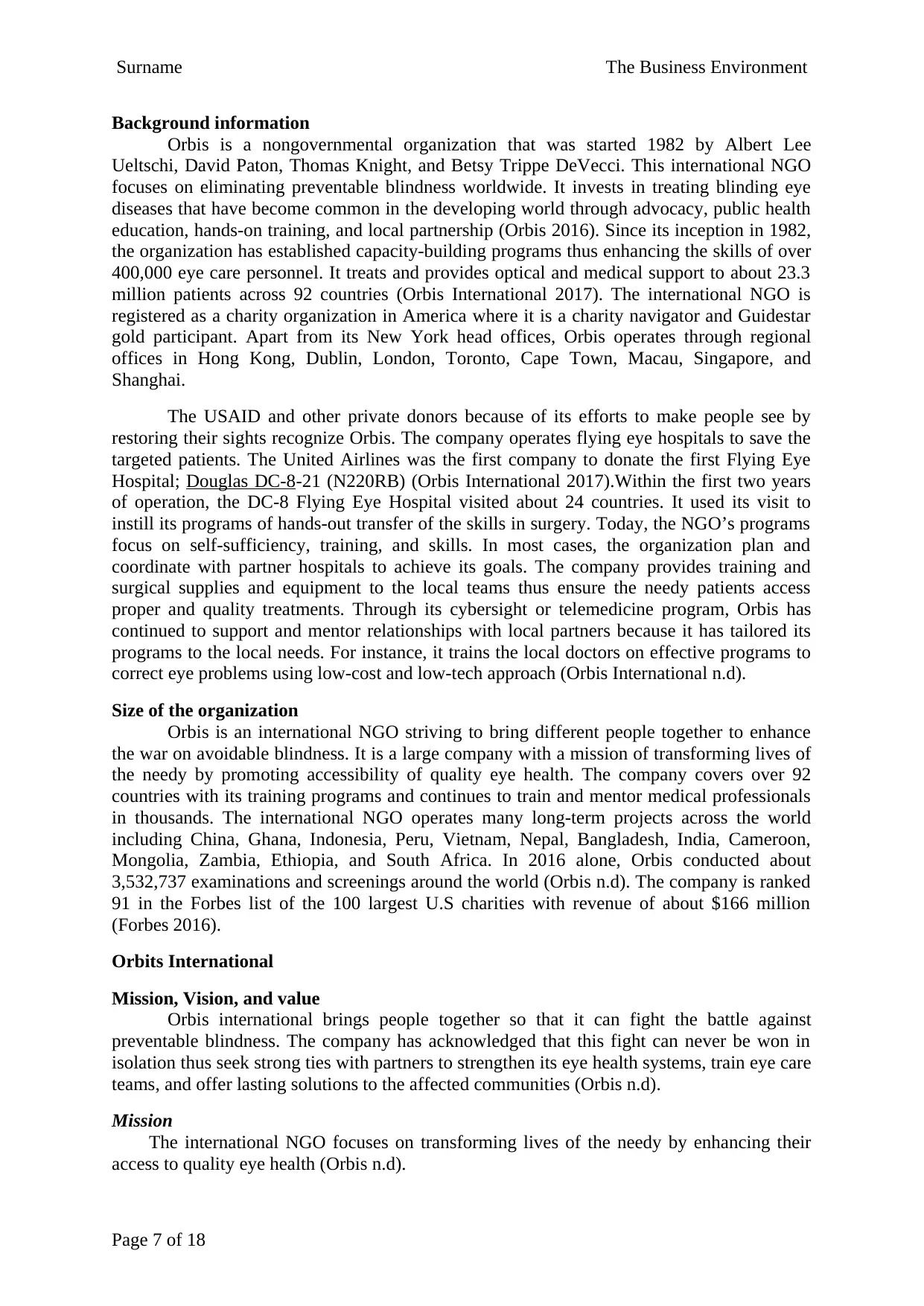
Surname The Business Environment
Background information
Orbis is a nongovernmental organization that was started 1982 by Albert Lee
Ueltschi, David Paton, Thomas Knight, and Betsy Trippe DeVecci. This international NGO
focuses on eliminating preventable blindness worldwide. It invests in treating blinding eye
diseases that have become common in the developing world through advocacy, public health
education, hands-on training, and local partnership (Orbis 2016). Since its inception in 1982,
the organization has established capacity-building programs thus enhancing the skills of over
400,000 eye care personnel. It treats and provides optical and medical support to about 23.3
million patients across 92 countries (Orbis International 2017). The international NGO is
registered as a charity organization in America where it is a charity navigator and Guidestar
gold participant. Apart from its New York head offices, Orbis operates through regional
offices in Hong Kong, Dublin, London, Toronto, Cape Town, Macau, Singapore, and
Shanghai.
The USAID and other private donors because of its efforts to make people see by
restoring their sights recognize Orbis. The company operates flying eye hospitals to save the
targeted patients. The United Airlines was the first company to donate the first Flying Eye
Hospital; Douglas DC-8-21 (N220RB) (Orbis International 2017).Within the first two years
of operation, the DC-8 Flying Eye Hospital visited about 24 countries. It used its visit to
instill its programs of hands-out transfer of the skills in surgery. Today, the NGO’s programs
focus on self-sufficiency, training, and skills. In most cases, the organization plan and
coordinate with partner hospitals to achieve its goals. The company provides training and
surgical supplies and equipment to the local teams thus ensure the needy patients access
proper and quality treatments. Through its cybersight or telemedicine program, Orbis has
continued to support and mentor relationships with local partners because it has tailored its
programs to the local needs. For instance, it trains the local doctors on effective programs to
correct eye problems using low-cost and low-tech approach (Orbis International n.d).
Size of the organization
Orbis is an international NGO striving to bring different people together to enhance
the war on avoidable blindness. It is a large company with a mission of transforming lives of
the needy by promoting accessibility of quality eye health. The company covers over 92
countries with its training programs and continues to train and mentor medical professionals
in thousands. The international NGO operates many long-term projects across the world
including China, Ghana, Indonesia, Peru, Vietnam, Nepal, Bangladesh, India, Cameroon,
Mongolia, Zambia, Ethiopia, and South Africa. In 2016 alone, Orbis conducted about
3,532,737 examinations and screenings around the world (Orbis n.d). The company is ranked
91 in the Forbes list of the 100 largest U.S charities with revenue of about $166 million
(Forbes 2016).
Orbits International
Mission, Vision, and value
Orbis international brings people together so that it can fight the battle against
preventable blindness. The company has acknowledged that this fight can never be won in
isolation thus seek strong ties with partners to strengthen its eye health systems, train eye care
teams, and offer lasting solutions to the affected communities (Orbis n.d).
Mission
The international NGO focuses on transforming lives of the needy by enhancing their
access to quality eye health (Orbis n.d).
Page 7 of 18
Background information
Orbis is a nongovernmental organization that was started 1982 by Albert Lee
Ueltschi, David Paton, Thomas Knight, and Betsy Trippe DeVecci. This international NGO
focuses on eliminating preventable blindness worldwide. It invests in treating blinding eye
diseases that have become common in the developing world through advocacy, public health
education, hands-on training, and local partnership (Orbis 2016). Since its inception in 1982,
the organization has established capacity-building programs thus enhancing the skills of over
400,000 eye care personnel. It treats and provides optical and medical support to about 23.3
million patients across 92 countries (Orbis International 2017). The international NGO is
registered as a charity organization in America where it is a charity navigator and Guidestar
gold participant. Apart from its New York head offices, Orbis operates through regional
offices in Hong Kong, Dublin, London, Toronto, Cape Town, Macau, Singapore, and
Shanghai.
The USAID and other private donors because of its efforts to make people see by
restoring their sights recognize Orbis. The company operates flying eye hospitals to save the
targeted patients. The United Airlines was the first company to donate the first Flying Eye
Hospital; Douglas DC-8-21 (N220RB) (Orbis International 2017).Within the first two years
of operation, the DC-8 Flying Eye Hospital visited about 24 countries. It used its visit to
instill its programs of hands-out transfer of the skills in surgery. Today, the NGO’s programs
focus on self-sufficiency, training, and skills. In most cases, the organization plan and
coordinate with partner hospitals to achieve its goals. The company provides training and
surgical supplies and equipment to the local teams thus ensure the needy patients access
proper and quality treatments. Through its cybersight or telemedicine program, Orbis has
continued to support and mentor relationships with local partners because it has tailored its
programs to the local needs. For instance, it trains the local doctors on effective programs to
correct eye problems using low-cost and low-tech approach (Orbis International n.d).
Size of the organization
Orbis is an international NGO striving to bring different people together to enhance
the war on avoidable blindness. It is a large company with a mission of transforming lives of
the needy by promoting accessibility of quality eye health. The company covers over 92
countries with its training programs and continues to train and mentor medical professionals
in thousands. The international NGO operates many long-term projects across the world
including China, Ghana, Indonesia, Peru, Vietnam, Nepal, Bangladesh, India, Cameroon,
Mongolia, Zambia, Ethiopia, and South Africa. In 2016 alone, Orbis conducted about
3,532,737 examinations and screenings around the world (Orbis n.d). The company is ranked
91 in the Forbes list of the 100 largest U.S charities with revenue of about $166 million
(Forbes 2016).
Orbits International
Mission, Vision, and value
Orbis international brings people together so that it can fight the battle against
preventable blindness. The company has acknowledged that this fight can never be won in
isolation thus seek strong ties with partners to strengthen its eye health systems, train eye care
teams, and offer lasting solutions to the affected communities (Orbis n.d).
Mission
The international NGO focuses on transforming lives of the needy by enhancing their
access to quality eye health (Orbis n.d).
Page 7 of 18
Paraphrase This Document
Need a fresh take? Get an instant paraphrase of this document with our AI Paraphraser
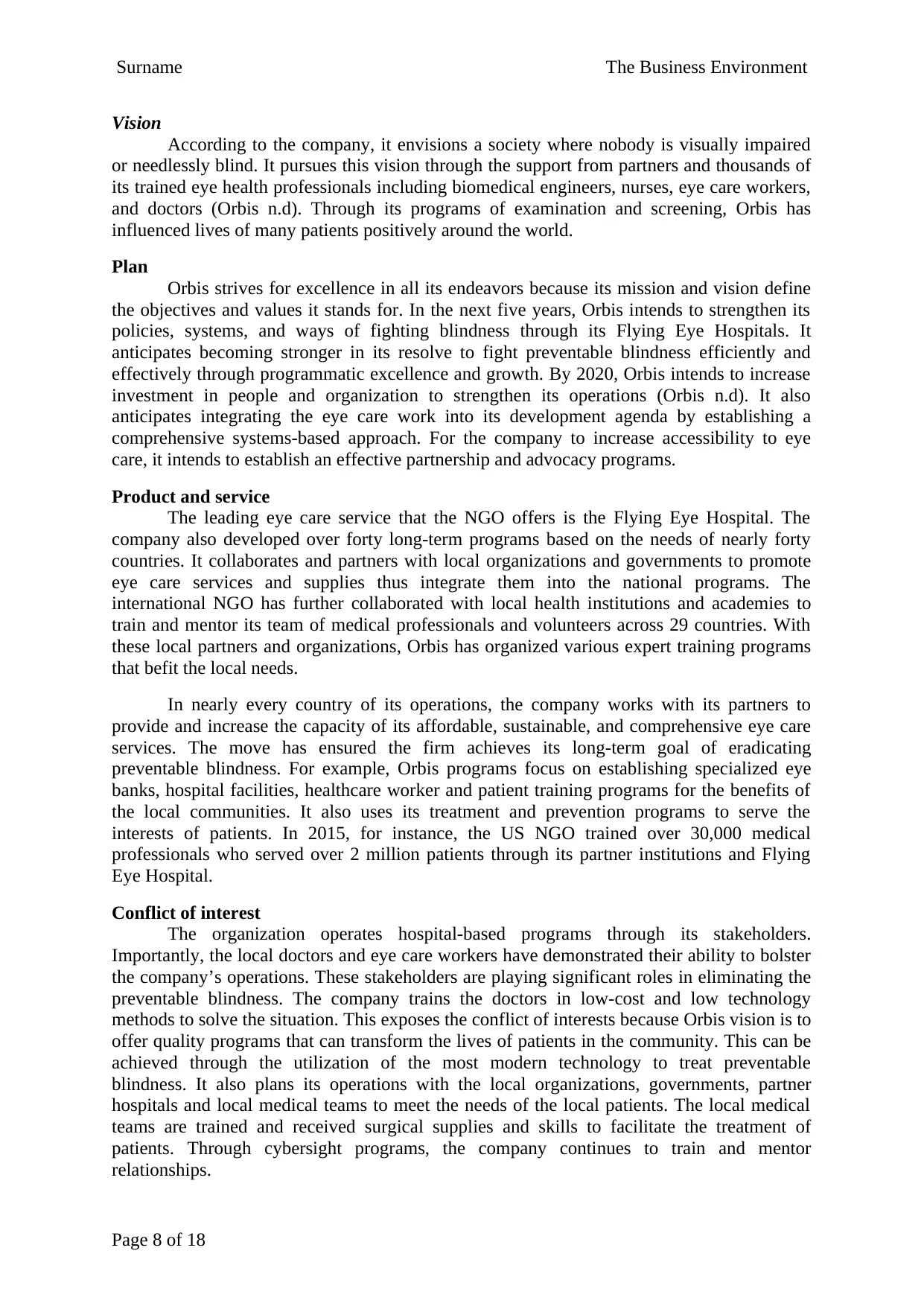
Surname The Business Environment
Vision
According to the company, it envisions a society where nobody is visually impaired
or needlessly blind. It pursues this vision through the support from partners and thousands of
its trained eye health professionals including biomedical engineers, nurses, eye care workers,
and doctors (Orbis n.d). Through its programs of examination and screening, Orbis has
influenced lives of many patients positively around the world.
Plan
Orbis strives for excellence in all its endeavors because its mission and vision define
the objectives and values it stands for. In the next five years, Orbis intends to strengthen its
policies, systems, and ways of fighting blindness through its Flying Eye Hospitals. It
anticipates becoming stronger in its resolve to fight preventable blindness efficiently and
effectively through programmatic excellence and growth. By 2020, Orbis intends to increase
investment in people and organization to strengthen its operations (Orbis n.d). It also
anticipates integrating the eye care work into its development agenda by establishing a
comprehensive systems-based approach. For the company to increase accessibility to eye
care, it intends to establish an effective partnership and advocacy programs.
Product and service
The leading eye care service that the NGO offers is the Flying Eye Hospital. The
company also developed over forty long-term programs based on the needs of nearly forty
countries. It collaborates and partners with local organizations and governments to promote
eye care services and supplies thus integrate them into the national programs. The
international NGO has further collaborated with local health institutions and academies to
train and mentor its team of medical professionals and volunteers across 29 countries. With
these local partners and organizations, Orbis has organized various expert training programs
that befit the local needs.
In nearly every country of its operations, the company works with its partners to
provide and increase the capacity of its affordable, sustainable, and comprehensive eye care
services. The move has ensured the firm achieves its long-term goal of eradicating
preventable blindness. For example, Orbis programs focus on establishing specialized eye
banks, hospital facilities, healthcare worker and patient training programs for the benefits of
the local communities. It also uses its treatment and prevention programs to serve the
interests of patients. In 2015, for instance, the US NGO trained over 30,000 medical
professionals who served over 2 million patients through its partner institutions and Flying
Eye Hospital.
Conflict of interest
The organization operates hospital-based programs through its stakeholders.
Importantly, the local doctors and eye care workers have demonstrated their ability to bolster
the company’s operations. These stakeholders are playing significant roles in eliminating the
preventable blindness. The company trains the doctors in low-cost and low technology
methods to solve the situation. This exposes the conflict of interests because Orbis vision is to
offer quality programs that can transform the lives of patients in the community. This can be
achieved through the utilization of the most modern technology to treat preventable
blindness. It also plans its operations with the local organizations, governments, partner
hospitals and local medical teams to meet the needs of the local patients. The local medical
teams are trained and received surgical supplies and skills to facilitate the treatment of
patients. Through cybersight programs, the company continues to train and mentor
relationships.
Page 8 of 18
Vision
According to the company, it envisions a society where nobody is visually impaired
or needlessly blind. It pursues this vision through the support from partners and thousands of
its trained eye health professionals including biomedical engineers, nurses, eye care workers,
and doctors (Orbis n.d). Through its programs of examination and screening, Orbis has
influenced lives of many patients positively around the world.
Plan
Orbis strives for excellence in all its endeavors because its mission and vision define
the objectives and values it stands for. In the next five years, Orbis intends to strengthen its
policies, systems, and ways of fighting blindness through its Flying Eye Hospitals. It
anticipates becoming stronger in its resolve to fight preventable blindness efficiently and
effectively through programmatic excellence and growth. By 2020, Orbis intends to increase
investment in people and organization to strengthen its operations (Orbis n.d). It also
anticipates integrating the eye care work into its development agenda by establishing a
comprehensive systems-based approach. For the company to increase accessibility to eye
care, it intends to establish an effective partnership and advocacy programs.
Product and service
The leading eye care service that the NGO offers is the Flying Eye Hospital. The
company also developed over forty long-term programs based on the needs of nearly forty
countries. It collaborates and partners with local organizations and governments to promote
eye care services and supplies thus integrate them into the national programs. The
international NGO has further collaborated with local health institutions and academies to
train and mentor its team of medical professionals and volunteers across 29 countries. With
these local partners and organizations, Orbis has organized various expert training programs
that befit the local needs.
In nearly every country of its operations, the company works with its partners to
provide and increase the capacity of its affordable, sustainable, and comprehensive eye care
services. The move has ensured the firm achieves its long-term goal of eradicating
preventable blindness. For example, Orbis programs focus on establishing specialized eye
banks, hospital facilities, healthcare worker and patient training programs for the benefits of
the local communities. It also uses its treatment and prevention programs to serve the
interests of patients. In 2015, for instance, the US NGO trained over 30,000 medical
professionals who served over 2 million patients through its partner institutions and Flying
Eye Hospital.
Conflict of interest
The organization operates hospital-based programs through its stakeholders.
Importantly, the local doctors and eye care workers have demonstrated their ability to bolster
the company’s operations. These stakeholders are playing significant roles in eliminating the
preventable blindness. The company trains the doctors in low-cost and low technology
methods to solve the situation. This exposes the conflict of interests because Orbis vision is to
offer quality programs that can transform the lives of patients in the community. This can be
achieved through the utilization of the most modern technology to treat preventable
blindness. It also plans its operations with the local organizations, governments, partner
hospitals and local medical teams to meet the needs of the local patients. The local medical
teams are trained and received surgical supplies and skills to facilitate the treatment of
patients. Through cybersight programs, the company continues to train and mentor
relationships.
Page 8 of 18

Surname The Business Environment
Legal structure
Orbis is an international NGO focusing on saving sight across the world. In most
cases, its programs are tailored towards preventing blindness and training blinding eye
syndromes, especially in the emerging economies. It pursues its mission through public
health education, hands-on training, local partnerships, and advocacy. The operations of this
NGO is defined by the American constitution under section 501 (c) (3) of tax-deductible non-
profit charity.
MTR
Background information
The corporation was established in 2000 in Hong Kong, where it succeeded the Mass
Transit Railway Corporation that began in 1975. The Mass Transit Railways (MTR) was a
government-owned statutory corporation mandated to operate MTSR system. In October
2000, the company was listed on the Hong Kong’s Stock Exchange following successful
IPOs.
Currently, this large company operates the 87.7 Kilometres route, which serves 50
stations. The organization serves about 2.3 million passengers daily thus making the MTR
system most intensive and efficient. With this huge daily patronage, the organization is a
successful venture. In fact, it has diversified its operations in development, management, and
sales of commercial and residential properties adjust to its stations. It further collaborates
with various property developers to meet its objectives.
About MTR
Vision and mission
The company is aiming to become a global leader connecting and growing
communities with quality services. The company believes that this vision is achievable
through its outstanding businesses and railway operations and constructions.
MTR has also created a mission to help it improve quality of life for customers
beyond their needs and expectations. It anticipates achieving this mission by providing
sustainable returns to its investors, engaging communities, and setting up a culture that
promotes staff growth, learning, and pride. Similarly, MTR anticipates achieving its market
leadership by expanding in mainland China, Hong Kong, and Europe thus maximize its core
capability. The company has incessantly established new definitions to enhance creative
strategies and improve its operations.
Value
The guiding values of this company include outstanding service, mutual respect, value
creation, and enterprise spirit. The company achieves its outstanding service by focusing on
offering safe, efficient, and caring services that meet the expectations and needs of customers.
The company also values its enterprising spirit because it anticipates serving the interests of
shareholders. It believes in disruptive activities by questioning the significance of status quo
thus seek improvement. It has incessantly taken proactive initiatives to overcome business
challenges and realize new prospects. The business also values mutual respect by establishing
an open team environment where team members share commitment, respect, and
expectations. The open team environment has promoted hard work and creativity among
different members of the society. Indeed, the management has instilled the value in the
Page 9 of 18
Legal structure
Orbis is an international NGO focusing on saving sight across the world. In most
cases, its programs are tailored towards preventing blindness and training blinding eye
syndromes, especially in the emerging economies. It pursues its mission through public
health education, hands-on training, local partnerships, and advocacy. The operations of this
NGO is defined by the American constitution under section 501 (c) (3) of tax-deductible non-
profit charity.
MTR
Background information
The corporation was established in 2000 in Hong Kong, where it succeeded the Mass
Transit Railway Corporation that began in 1975. The Mass Transit Railways (MTR) was a
government-owned statutory corporation mandated to operate MTSR system. In October
2000, the company was listed on the Hong Kong’s Stock Exchange following successful
IPOs.
Currently, this large company operates the 87.7 Kilometres route, which serves 50
stations. The organization serves about 2.3 million passengers daily thus making the MTR
system most intensive and efficient. With this huge daily patronage, the organization is a
successful venture. In fact, it has diversified its operations in development, management, and
sales of commercial and residential properties adjust to its stations. It further collaborates
with various property developers to meet its objectives.
About MTR
Vision and mission
The company is aiming to become a global leader connecting and growing
communities with quality services. The company believes that this vision is achievable
through its outstanding businesses and railway operations and constructions.
MTR has also created a mission to help it improve quality of life for customers
beyond their needs and expectations. It anticipates achieving this mission by providing
sustainable returns to its investors, engaging communities, and setting up a culture that
promotes staff growth, learning, and pride. Similarly, MTR anticipates achieving its market
leadership by expanding in mainland China, Hong Kong, and Europe thus maximize its core
capability. The company has incessantly established new definitions to enhance creative
strategies and improve its operations.
Value
The guiding values of this company include outstanding service, mutual respect, value
creation, and enterprise spirit. The company achieves its outstanding service by focusing on
offering safe, efficient, and caring services that meet the expectations and needs of customers.
The company also values its enterprising spirit because it anticipates serving the interests of
shareholders. It believes in disruptive activities by questioning the significance of status quo
thus seek improvement. It has incessantly taken proactive initiatives to overcome business
challenges and realize new prospects. The business also values mutual respect by establishing
an open team environment where team members share commitment, respect, and
expectations. The open team environment has promoted hard work and creativity among
different members of the society. Indeed, the management has instilled the value in the
Page 9 of 18
⊘ This is a preview!⊘
Do you want full access?
Subscribe today to unlock all pages.

Trusted by 1+ million students worldwide
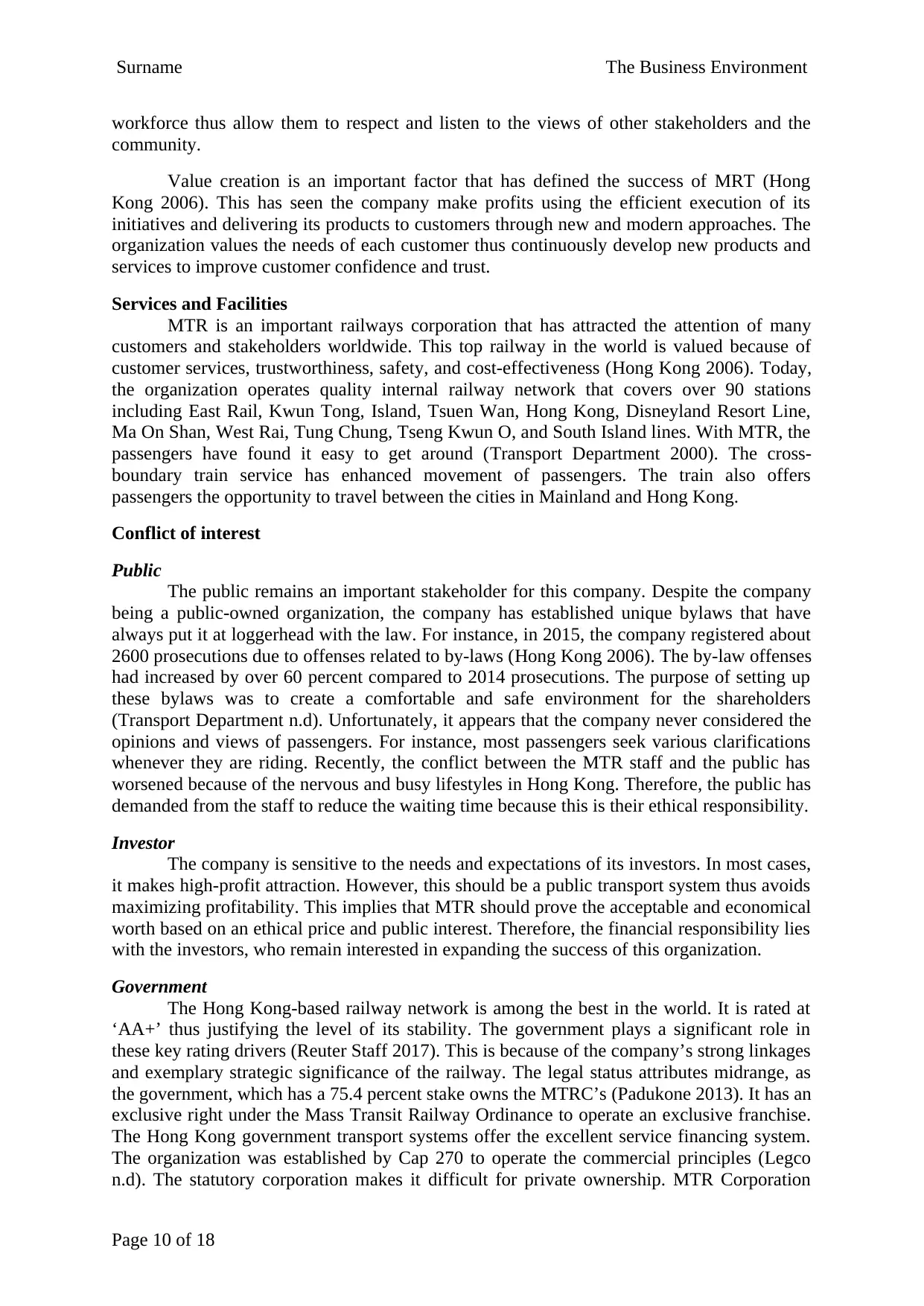
Surname The Business Environment
workforce thus allow them to respect and listen to the views of other stakeholders and the
community.
Value creation is an important factor that has defined the success of MRT (Hong
Kong 2006). This has seen the company make profits using the efficient execution of its
initiatives and delivering its products to customers through new and modern approaches. The
organization values the needs of each customer thus continuously develop new products and
services to improve customer confidence and trust.
Services and Facilities
MTR is an important railways corporation that has attracted the attention of many
customers and stakeholders worldwide. This top railway in the world is valued because of
customer services, trustworthiness, safety, and cost-effectiveness (Hong Kong 2006). Today,
the organization operates quality internal railway network that covers over 90 stations
including East Rail, Kwun Tong, Island, Tsuen Wan, Hong Kong, Disneyland Resort Line,
Ma On Shan, West Rai, Tung Chung, Tseng Kwun O, and South Island lines. With MTR, the
passengers have found it easy to get around (Transport Department 2000). The cross-
boundary train service has enhanced movement of passengers. The train also offers
passengers the opportunity to travel between the cities in Mainland and Hong Kong.
Conflict of interest
Public
The public remains an important stakeholder for this company. Despite the company
being a public-owned organization, the company has established unique bylaws that have
always put it at loggerhead with the law. For instance, in 2015, the company registered about
2600 prosecutions due to offenses related to by-laws (Hong Kong 2006). The by-law offenses
had increased by over 60 percent compared to 2014 prosecutions. The purpose of setting up
these bylaws was to create a comfortable and safe environment for the shareholders
(Transport Department n.d). Unfortunately, it appears that the company never considered the
opinions and views of passengers. For instance, most passengers seek various clarifications
whenever they are riding. Recently, the conflict between the MTR staff and the public has
worsened because of the nervous and busy lifestyles in Hong Kong. Therefore, the public has
demanded from the staff to reduce the waiting time because this is their ethical responsibility.
Investor
The company is sensitive to the needs and expectations of its investors. In most cases,
it makes high-profit attraction. However, this should be a public transport system thus avoids
maximizing profitability. This implies that MTR should prove the acceptable and economical
worth based on an ethical price and public interest. Therefore, the financial responsibility lies
with the investors, who remain interested in expanding the success of this organization.
Government
The Hong Kong-based railway network is among the best in the world. It is rated at
‘AA+’ thus justifying the level of its stability. The government plays a significant role in
these key rating drivers (Reuter Staff 2017). This is because of the company’s strong linkages
and exemplary strategic significance of the railway. The legal status attributes midrange, as
the government, which has a 75.4 percent stake owns the MTRC’s (Padukone 2013). It has an
exclusive right under the Mass Transit Railway Ordinance to operate an exclusive franchise.
The Hong Kong government transport systems offer the excellent service financing system.
The organization was established by Cap 270 to operate the commercial principles (Legco
n.d). The statutory corporation makes it difficult for private ownership. MTR Corporation
Page 10 of 18
workforce thus allow them to respect and listen to the views of other stakeholders and the
community.
Value creation is an important factor that has defined the success of MRT (Hong
Kong 2006). This has seen the company make profits using the efficient execution of its
initiatives and delivering its products to customers through new and modern approaches. The
organization values the needs of each customer thus continuously develop new products and
services to improve customer confidence and trust.
Services and Facilities
MTR is an important railways corporation that has attracted the attention of many
customers and stakeholders worldwide. This top railway in the world is valued because of
customer services, trustworthiness, safety, and cost-effectiveness (Hong Kong 2006). Today,
the organization operates quality internal railway network that covers over 90 stations
including East Rail, Kwun Tong, Island, Tsuen Wan, Hong Kong, Disneyland Resort Line,
Ma On Shan, West Rai, Tung Chung, Tseng Kwun O, and South Island lines. With MTR, the
passengers have found it easy to get around (Transport Department 2000). The cross-
boundary train service has enhanced movement of passengers. The train also offers
passengers the opportunity to travel between the cities in Mainland and Hong Kong.
Conflict of interest
Public
The public remains an important stakeholder for this company. Despite the company
being a public-owned organization, the company has established unique bylaws that have
always put it at loggerhead with the law. For instance, in 2015, the company registered about
2600 prosecutions due to offenses related to by-laws (Hong Kong 2006). The by-law offenses
had increased by over 60 percent compared to 2014 prosecutions. The purpose of setting up
these bylaws was to create a comfortable and safe environment for the shareholders
(Transport Department n.d). Unfortunately, it appears that the company never considered the
opinions and views of passengers. For instance, most passengers seek various clarifications
whenever they are riding. Recently, the conflict between the MTR staff and the public has
worsened because of the nervous and busy lifestyles in Hong Kong. Therefore, the public has
demanded from the staff to reduce the waiting time because this is their ethical responsibility.
Investor
The company is sensitive to the needs and expectations of its investors. In most cases,
it makes high-profit attraction. However, this should be a public transport system thus avoids
maximizing profitability. This implies that MTR should prove the acceptable and economical
worth based on an ethical price and public interest. Therefore, the financial responsibility lies
with the investors, who remain interested in expanding the success of this organization.
Government
The Hong Kong-based railway network is among the best in the world. It is rated at
‘AA+’ thus justifying the level of its stability. The government plays a significant role in
these key rating drivers (Reuter Staff 2017). This is because of the company’s strong linkages
and exemplary strategic significance of the railway. The legal status attributes midrange, as
the government, which has a 75.4 percent stake owns the MTRC’s (Padukone 2013). It has an
exclusive right under the Mass Transit Railway Ordinance to operate an exclusive franchise.
The Hong Kong government transport systems offer the excellent service financing system.
The organization was established by Cap 270 to operate the commercial principles (Legco
n.d). The statutory corporation makes it difficult for private ownership. MTR Corporation
Page 10 of 18
Paraphrase This Document
Need a fresh take? Get an instant paraphrase of this document with our AI Paraphraser
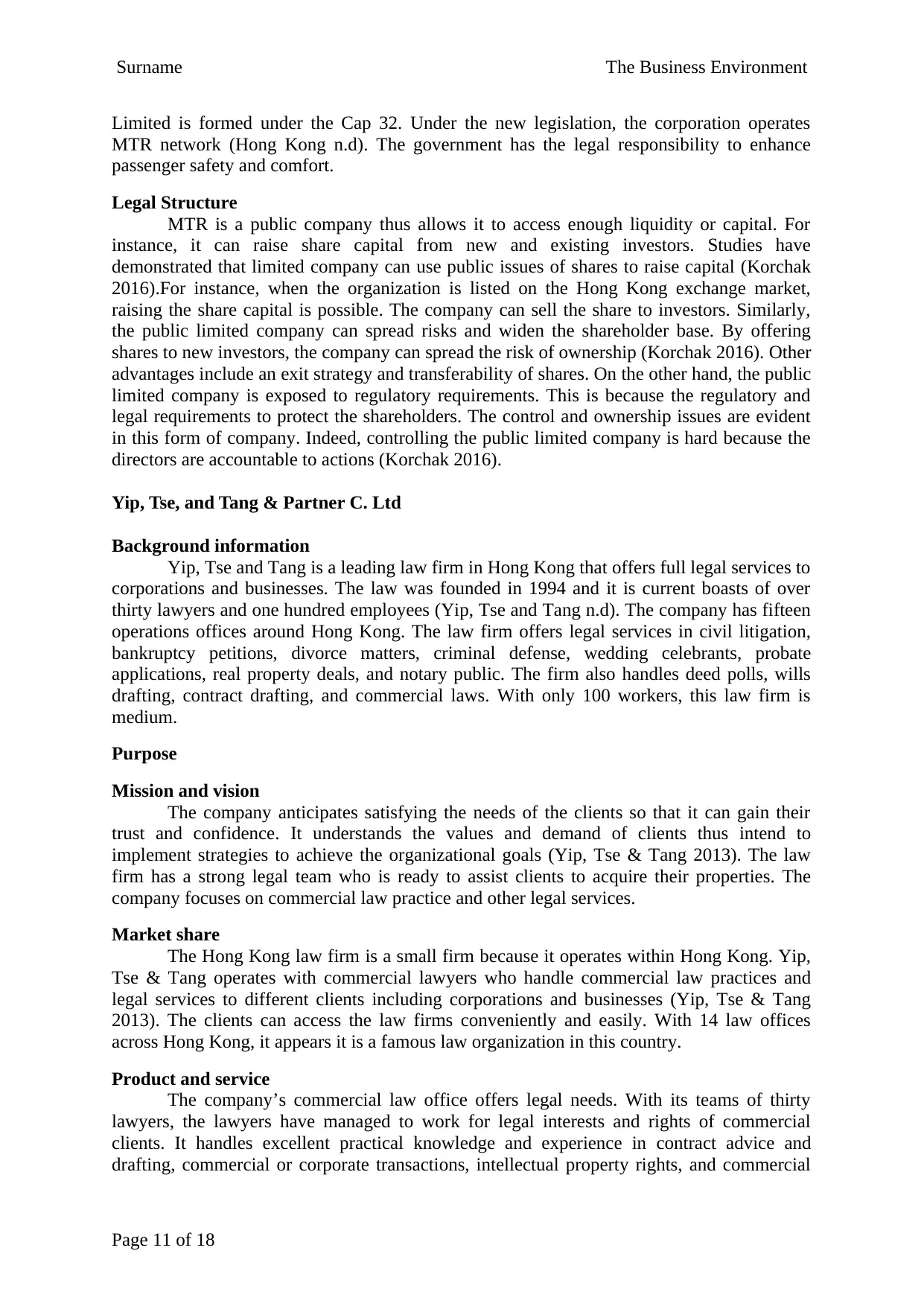
Surname The Business Environment
Limited is formed under the Cap 32. Under the new legislation, the corporation operates
MTR network (Hong Kong n.d). The government has the legal responsibility to enhance
passenger safety and comfort.
Legal Structure
MTR is a public company thus allows it to access enough liquidity or capital. For
instance, it can raise share capital from new and existing investors. Studies have
demonstrated that limited company can use public issues of shares to raise capital (Korchak
2016).For instance, when the organization is listed on the Hong Kong exchange market,
raising the share capital is possible. The company can sell the share to investors. Similarly,
the public limited company can spread risks and widen the shareholder base. By offering
shares to new investors, the company can spread the risk of ownership (Korchak 2016). Other
advantages include an exit strategy and transferability of shares. On the other hand, the public
limited company is exposed to regulatory requirements. This is because the regulatory and
legal requirements to protect the shareholders. The control and ownership issues are evident
in this form of company. Indeed, controlling the public limited company is hard because the
directors are accountable to actions (Korchak 2016).
Yip, Tse, and Tang & Partner C. Ltd
Background information
Yip, Tse and Tang is a leading law firm in Hong Kong that offers full legal services to
corporations and businesses. The law was founded in 1994 and it is current boasts of over
thirty lawyers and one hundred employees (Yip, Tse and Tang n.d). The company has fifteen
operations offices around Hong Kong. The law firm offers legal services in civil litigation,
bankruptcy petitions, divorce matters, criminal defense, wedding celebrants, probate
applications, real property deals, and notary public. The firm also handles deed polls, wills
drafting, contract drafting, and commercial laws. With only 100 workers, this law firm is
medium.
Purpose
Mission and vision
The company anticipates satisfying the needs of the clients so that it can gain their
trust and confidence. It understands the values and demand of clients thus intend to
implement strategies to achieve the organizational goals (Yip, Tse & Tang 2013). The law
firm has a strong legal team who is ready to assist clients to acquire their properties. The
company focuses on commercial law practice and other legal services.
Market share
The Hong Kong law firm is a small firm because it operates within Hong Kong. Yip,
Tse & Tang operates with commercial lawyers who handle commercial law practices and
legal services to different clients including corporations and businesses (Yip, Tse & Tang
2013). The clients can access the law firms conveniently and easily. With 14 law offices
across Hong Kong, it appears it is a famous law organization in this country.
Product and service
The company’s commercial law office offers legal needs. With its teams of thirty
lawyers, the lawyers have managed to work for legal interests and rights of commercial
clients. It handles excellent practical knowledge and experience in contract advice and
drafting, commercial or corporate transactions, intellectual property rights, and commercial
Page 11 of 18
Limited is formed under the Cap 32. Under the new legislation, the corporation operates
MTR network (Hong Kong n.d). The government has the legal responsibility to enhance
passenger safety and comfort.
Legal Structure
MTR is a public company thus allows it to access enough liquidity or capital. For
instance, it can raise share capital from new and existing investors. Studies have
demonstrated that limited company can use public issues of shares to raise capital (Korchak
2016).For instance, when the organization is listed on the Hong Kong exchange market,
raising the share capital is possible. The company can sell the share to investors. Similarly,
the public limited company can spread risks and widen the shareholder base. By offering
shares to new investors, the company can spread the risk of ownership (Korchak 2016). Other
advantages include an exit strategy and transferability of shares. On the other hand, the public
limited company is exposed to regulatory requirements. This is because the regulatory and
legal requirements to protect the shareholders. The control and ownership issues are evident
in this form of company. Indeed, controlling the public limited company is hard because the
directors are accountable to actions (Korchak 2016).
Yip, Tse, and Tang & Partner C. Ltd
Background information
Yip, Tse and Tang is a leading law firm in Hong Kong that offers full legal services to
corporations and businesses. The law was founded in 1994 and it is current boasts of over
thirty lawyers and one hundred employees (Yip, Tse and Tang n.d). The company has fifteen
operations offices around Hong Kong. The law firm offers legal services in civil litigation,
bankruptcy petitions, divorce matters, criminal defense, wedding celebrants, probate
applications, real property deals, and notary public. The firm also handles deed polls, wills
drafting, contract drafting, and commercial laws. With only 100 workers, this law firm is
medium.
Purpose
Mission and vision
The company anticipates satisfying the needs of the clients so that it can gain their
trust and confidence. It understands the values and demand of clients thus intend to
implement strategies to achieve the organizational goals (Yip, Tse & Tang 2013). The law
firm has a strong legal team who is ready to assist clients to acquire their properties. The
company focuses on commercial law practice and other legal services.
Market share
The Hong Kong law firm is a small firm because it operates within Hong Kong. Yip,
Tse & Tang operates with commercial lawyers who handle commercial law practices and
legal services to different clients including corporations and businesses (Yip, Tse & Tang
2013). The clients can access the law firms conveniently and easily. With 14 law offices
across Hong Kong, it appears it is a famous law organization in this country.
Product and service
The company’s commercial law office offers legal needs. With its teams of thirty
lawyers, the lawyers have managed to work for legal interests and rights of commercial
clients. It handles excellent practical knowledge and experience in contract advice and
drafting, commercial or corporate transactions, intellectual property rights, and commercial
Page 11 of 18
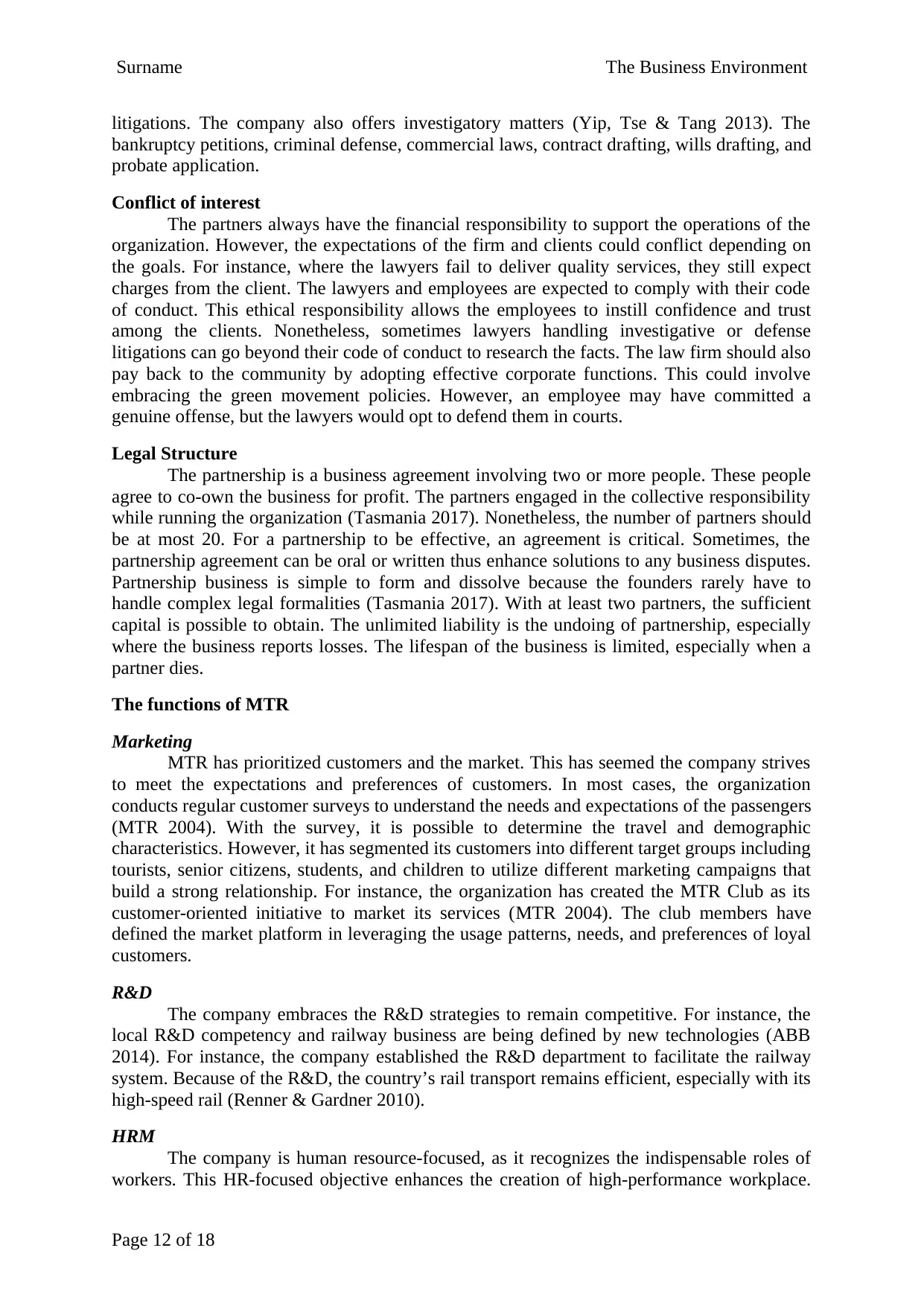
Surname The Business Environment
litigations. The company also offers investigatory matters (Yip, Tse & Tang 2013). The
bankruptcy petitions, criminal defense, commercial laws, contract drafting, wills drafting, and
probate application.
Conflict of interest
The partners always have the financial responsibility to support the operations of the
organization. However, the expectations of the firm and clients could conflict depending on
the goals. For instance, where the lawyers fail to deliver quality services, they still expect
charges from the client. The lawyers and employees are expected to comply with their code
of conduct. This ethical responsibility allows the employees to instill confidence and trust
among the clients. Nonetheless, sometimes lawyers handling investigative or defense
litigations can go beyond their code of conduct to research the facts. The law firm should also
pay back to the community by adopting effective corporate functions. This could involve
embracing the green movement policies. However, an employee may have committed a
genuine offense, but the lawyers would opt to defend them in courts.
Legal Structure
The partnership is a business agreement involving two or more people. These people
agree to co-own the business for profit. The partners engaged in the collective responsibility
while running the organization (Tasmania 2017). Nonetheless, the number of partners should
be at most 20. For a partnership to be effective, an agreement is critical. Sometimes, the
partnership agreement can be oral or written thus enhance solutions to any business disputes.
Partnership business is simple to form and dissolve because the founders rarely have to
handle complex legal formalities (Tasmania 2017). With at least two partners, the sufficient
capital is possible to obtain. The unlimited liability is the undoing of partnership, especially
where the business reports losses. The lifespan of the business is limited, especially when a
partner dies.
The functions of MTR
Marketing
MTR has prioritized customers and the market. This has seemed the company strives
to meet the expectations and preferences of customers. In most cases, the organization
conducts regular customer surveys to understand the needs and expectations of the passengers
(MTR 2004). With the survey, it is possible to determine the travel and demographic
characteristics. However, it has segmented its customers into different target groups including
tourists, senior citizens, students, and children to utilize different marketing campaigns that
build a strong relationship. For instance, the organization has created the MTR Club as its
customer-oriented initiative to market its services (MTR 2004). The club members have
defined the market platform in leveraging the usage patterns, needs, and preferences of loyal
customers.
R&D
The company embraces the R&D strategies to remain competitive. For instance, the
local R&D competency and railway business are being defined by new technologies (ABB
2014). For instance, the company established the R&D department to facilitate the railway
system. Because of the R&D, the country’s rail transport remains efficient, especially with its
high-speed rail (Renner & Gardner 2010).
HRM
The company is human resource-focused, as it recognizes the indispensable roles of
workers. This HR-focused objective enhances the creation of high-performance workplace.
Page 12 of 18
litigations. The company also offers investigatory matters (Yip, Tse & Tang 2013). The
bankruptcy petitions, criminal defense, commercial laws, contract drafting, wills drafting, and
probate application.
Conflict of interest
The partners always have the financial responsibility to support the operations of the
organization. However, the expectations of the firm and clients could conflict depending on
the goals. For instance, where the lawyers fail to deliver quality services, they still expect
charges from the client. The lawyers and employees are expected to comply with their code
of conduct. This ethical responsibility allows the employees to instill confidence and trust
among the clients. Nonetheless, sometimes lawyers handling investigative or defense
litigations can go beyond their code of conduct to research the facts. The law firm should also
pay back to the community by adopting effective corporate functions. This could involve
embracing the green movement policies. However, an employee may have committed a
genuine offense, but the lawyers would opt to defend them in courts.
Legal Structure
The partnership is a business agreement involving two or more people. These people
agree to co-own the business for profit. The partners engaged in the collective responsibility
while running the organization (Tasmania 2017). Nonetheless, the number of partners should
be at most 20. For a partnership to be effective, an agreement is critical. Sometimes, the
partnership agreement can be oral or written thus enhance solutions to any business disputes.
Partnership business is simple to form and dissolve because the founders rarely have to
handle complex legal formalities (Tasmania 2017). With at least two partners, the sufficient
capital is possible to obtain. The unlimited liability is the undoing of partnership, especially
where the business reports losses. The lifespan of the business is limited, especially when a
partner dies.
The functions of MTR
Marketing
MTR has prioritized customers and the market. This has seemed the company strives
to meet the expectations and preferences of customers. In most cases, the organization
conducts regular customer surveys to understand the needs and expectations of the passengers
(MTR 2004). With the survey, it is possible to determine the travel and demographic
characteristics. However, it has segmented its customers into different target groups including
tourists, senior citizens, students, and children to utilize different marketing campaigns that
build a strong relationship. For instance, the organization has created the MTR Club as its
customer-oriented initiative to market its services (MTR 2004). The club members have
defined the market platform in leveraging the usage patterns, needs, and preferences of loyal
customers.
R&D
The company embraces the R&D strategies to remain competitive. For instance, the
local R&D competency and railway business are being defined by new technologies (ABB
2014). For instance, the company established the R&D department to facilitate the railway
system. Because of the R&D, the country’s rail transport remains efficient, especially with its
high-speed rail (Renner & Gardner 2010).
HRM
The company is human resource-focused, as it recognizes the indispensable roles of
workers. This HR-focused objective enhances the creation of high-performance workplace.
Page 12 of 18
⊘ This is a preview!⊘
Do you want full access?
Subscribe today to unlock all pages.

Trusted by 1+ million students worldwide
1 out of 18
Related Documents
Your All-in-One AI-Powered Toolkit for Academic Success.
+13062052269
info@desklib.com
Available 24*7 on WhatsApp / Email
![[object Object]](/_next/static/media/star-bottom.7253800d.svg)
Unlock your academic potential
Copyright © 2020–2025 A2Z Services. All Rights Reserved. Developed and managed by ZUCOL.



